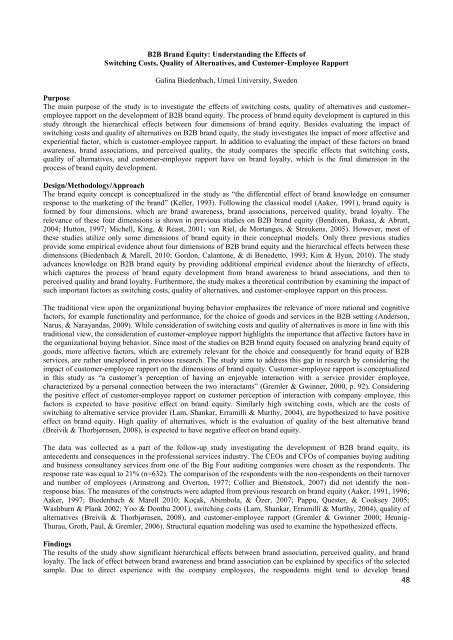Brand, Identity and Reputation: Exploring, Creating New Realities ...
Brand, Identity and Reputation: Exploring, Creating New Realities ...
Brand, Identity and Reputation: Exploring, Creating New Realities ...
You also want an ePaper? Increase the reach of your titles
YUMPU automatically turns print PDFs into web optimized ePapers that Google loves.
B2B <strong>Br<strong>and</strong></strong> Equity: Underst<strong>and</strong>ing the Effects of<br />
Switching Costs, Quality of Alternatives, <strong>and</strong> Customer-Employee Rapport<br />
Galina Biedenbach, Umeå University, Sweden<br />
Purpose<br />
The main purpose of the study is to investigate the effects of switching costs, quality of alternatives <strong>and</strong> customeremployee<br />
rapport on the development of B2B br<strong>and</strong> equity. The process of br<strong>and</strong> equity development is captured in this<br />
study through the hierarchical effects between four dimensions of br<strong>and</strong> equity. Besides evaluating the impact of<br />
switching costs <strong>and</strong> quality of alternatives on B2B br<strong>and</strong> equity, the study investigates the impact of more affective <strong>and</strong><br />
experiential factor, which is customer-employee rapport. In addition to evaluating the impact of these factors on br<strong>and</strong><br />
awareness, br<strong>and</strong> associations, <strong>and</strong> perceived quality, the study compares the specific effects that switching costs,<br />
quality of alternatives, <strong>and</strong> customer-employee rapport have on br<strong>and</strong> loyalty, which is the final dimension in the<br />
process of br<strong>and</strong> equity development.<br />
Design/Methodology/Approach<br />
The br<strong>and</strong> equity concept is conceptualized in the study as ―the differential effect of br<strong>and</strong> knowledge on consumer<br />
response to the marketing of the br<strong>and</strong>‖ (Keller, 1993). Following the classical model (Aaker, 1991), br<strong>and</strong> equity is<br />
formed by four dimensions, which are br<strong>and</strong> awareness, br<strong>and</strong> associations, perceived quality, br<strong>and</strong> loyalty. The<br />
relevance of these four dimensions is shown in previous studies on B2B br<strong>and</strong> equity (Bendixen, Bukasa, & Abratt,<br />
2004; Hutton, 1997; Michell, King, & Reast, 2001; van Riel, de Mortanges, & Streukens, 2005). However, most of<br />
these studies utilize only some dimensions of br<strong>and</strong> equity in their conceptual models. Only three previous studies<br />
provide some empirical evidence about four dimensions of B2B br<strong>and</strong> equity <strong>and</strong> the hierarchical effects between these<br />
dimensions (Biedenbach & Marell, 2010; Gordon, Calantone, & di Benedetto, 1993; Kim & Hyun, 2010). The study<br />
advances knowledge on B2B br<strong>and</strong> equity by providing additional empirical evidence about the hierarchy of effects,<br />
which captures the process of br<strong>and</strong> equity development from br<strong>and</strong> awareness to br<strong>and</strong> associations, <strong>and</strong> then to<br />
perceived quality <strong>and</strong> br<strong>and</strong> loyalty. Furthermore, the study makes a theoretical contribution by examining the impact of<br />
such important factors as switching costs, quality of alternatives, <strong>and</strong> customer-employee rapport on this process.<br />
The traditional view upon the organizational buying behavior emphasizes the relevance of more rational <strong>and</strong> cognitive<br />
factors, for example functionality <strong>and</strong> performance, for the choice of goods <strong>and</strong> services in the B2B setting (Anderson,<br />
Narus, & Naray<strong>and</strong>as, 2009). While consideration of switching costs <strong>and</strong> quality of alternatives is more in line with this<br />
traditional view, the consideration of customer-employee rapport highlights the importance that affective factors have in<br />
the organizational buying behavior. Since most of the studies on B2B br<strong>and</strong> equity focused on analyzing br<strong>and</strong> equity of<br />
goods, more affective factors, which are extremely relevant for the choice <strong>and</strong> consequently for br<strong>and</strong> equity of B2B<br />
services, are rather unexplored in previous research. The study aims to address this gap in research by considering the<br />
impact of customer-employee rapport on the dimensions of br<strong>and</strong> equity. Customer-employee rapport is conceptualized<br />
in this study as ―a customer‘s perception of having an enjoyable interaction with a service provider employee,<br />
characterized by a personal connection between the two interactants‖ (Gremler & Gwinner, 2000, p. 92). Considering<br />
the positive effect of customer-employee rapport on customer perception of interaction with company employee, this<br />
factors is expected to have positive effect on br<strong>and</strong> equity. Similarly high switching costs, which are the costs of<br />
switching to alternative service provider (Lam, Shankar, Erramilli & Murthy, 2004), are hypothesized to have positive<br />
effect on br<strong>and</strong> equity. High quality of alternatives, which is the evaluation of quality of the best alternative br<strong>and</strong><br />
(Breivik & Thorbjørnsen, 2008), is expected to have negative effect on br<strong>and</strong> equity.<br />
The data was collected as a part of the follow-up study investigating the development of B2B br<strong>and</strong> equity, its<br />
antecedents <strong>and</strong> consequences in the professional services industry. The CEOs <strong>and</strong> CFOs of companies buying auditing<br />
<strong>and</strong> business consultancy services from one of the Big Four auditing companies were chosen as the respondents. The<br />
response rate was equal to 21% (n=632). The comparison of the respondents with the non-respondents on their turnover<br />
<strong>and</strong> number of employees (Armstrong <strong>and</strong> Overton, 1977; Collier <strong>and</strong> Bienstock, 2007) did not identify the nonresponse<br />
bias. The measures of the constructs were adapted from previous research on br<strong>and</strong> equity (Aaker, 1991, 1996;<br />
Aaker, 1997; Biedenbach & Marell 2010; Koçak, Abimbola, & Özer, 2007; Pappu, Quester, & Cooksey 2005;<br />
Washburn & Plank 2002; Yoo & Donthu 2001), switching costs (Lam, Shankar, Erramilli & Murthy, 2004), quality of<br />
alternatives (Breivik & Thorbjørnsen, 2008), <strong>and</strong> customer-employee rapport (Gremler & Gwinner 2000; Hennig-<br />
Thurau, Groth, Paul, & Gremler, 2006). Structural equation modeling was used to examine the hypothesized effects.<br />
Findings<br />
The results of the study show significant hierarchical effects between br<strong>and</strong> association, perceived quality, <strong>and</strong> br<strong>and</strong><br />
loyalty. The lack of effect between br<strong>and</strong> awareness <strong>and</strong> br<strong>and</strong> association can be explained by specifics of the selected<br />
sample. Due to direct experience with the company employees, the respondents might tend to develop br<strong>and</strong><br />
48
















